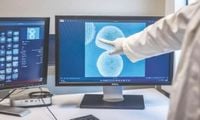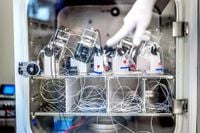In a laboratory nestled in Vevey, Switzerland, scientists are pushing the boundaries of technology and biology by building computers powered not by silicon chips, but by living human brain cells. The biotech startup FinalSpark, led by co-founder Fred Jordan, is at the forefront of this innovative field known as biocomputing—or, as some call it, wetware. Their work is challenging the very foundations of computing, raising profound questions about energy efficiency, the nature of intelligence, and even the edges of consciousness.
FinalSpark’s approach is as fascinating as it is unconventional. Rather than continuing the race to mimic the brain’s complexity with ever more sophisticated silicon semiconductors, the company is harnessing the real thing. As Jordan put it during a tour of the lab, “Instead of trying to mimic, let’s use the real thing.” According to Dawn, this philosophy has led to the creation of bioprocessors made from clusters of human neurons—dubbed brain organoids—grown from stem cells originally derived from anonymous human skin donors. These organoids, about the size of a fruit fly larva’s brain, are kept alive in nutrient-rich fluids and monitored with an array of electrodes.
Why go to such lengths? The answer, in part, is energy. The artificial intelligence boom, fueled by supercomputers running models like ChatGPT, has caused energy demands to skyrocket, threatening climate targets and forcing some tech giants to consider nuclear power. Biological neurons, however, are a million times more energy efficient than their artificial counterparts, Jordan explained to Daily Times. They can also be endlessly reproduced in the lab, sidestepping the supply constraints and environmental impact of traditional chip manufacturing.
The process of creating these living processors is painstaking. Scientists start with stem cells, coaxing them into becoming neurons. These are then clustered into millimeter-wide brain organoids. Electrodes are attached, allowing researchers to stimulate the organoids with small electric currents and monitor their responses. The resulting neural activity—spikes or silences—can be translated into digital signals, roughly analogous to the ones and zeroes of classic computing.
Yet, working with living cells presents unique challenges. As Benjamin Ward-Cherrier, a researcher at the University of Bristol, discovered, “Working with robots is very easy by comparison.” He used one of FinalSpark’s organoids as the brain for a simple robot that could distinguish between different Braille letters. But the fragility of life is ever-present in the lab; midway through an experiment, the organoid died, forcing Ward-Cherrier’s team to start over. According to FinalSpark, the organoids typically survive up to six months—a stark contrast to the near-infinite uptime of silicon chips.
Despite these hurdles, the research community is abuzz. Ten universities around the globe are currently experimenting with FinalSpark’s bioprocessors, exploring not just their potential for computing, but also their value in understanding the brain itself. At Johns Hopkins University, researcher Lena Smirnova is using similar organoids to study neurological disorders like Alzheimer’s and autism, hoping to unlock new treatments. “Biocomputing is currently more ‘pie in the sky,’ unlike the ‘low-hanging fruit’ use of the technology for biomedical research—but that could change dramatically over the next 20 years,” Smirnova told Dawn.
FinalSpark’s lab is a hive of activity and curiosity. The company even streams a live web feed of its organoids’ neural patterns, allowing the public to witness these mini-brains in action. The sight is both mesmerizing and a little uncanny—lines spike on screens in response to invisible cues. In one particularly puzzling observation, the scientists noticed that the organoids’ neural activity would suddenly spike whenever the fridge door containing them was opened, even though the cells have no known sensory mechanism for detecting such an event. “We still don’t understand how they detect the opening of the door,” Jordan admitted. It’s a mystery that underscores just how much remains unknown about the brain, even in its most rudimentary forms.
As with any technology that skirts the boundary between the living and the artificial, ethical considerations loom large. The idea of using living human cells—however primitive—as computer processors raises questions about consciousness, sentience, and responsibility. All the scientists involved are quick to dismiss the notion that these organoids could develop anything resembling consciousness. As Jordan put it, “This is at the edge of philosophy,” which is why FinalSpark collaborates closely with ethicists. He points out that the organoids, which lack pain receptors, have about 10,000 neurons—compared to the human brain’s staggering 100 billion. Still, the philosophical questions persist. What does it mean to use living tissue for computation? Could these mini-brains ever cross a threshold into awareness? For now, the consensus is a firm no, but the debate is far from settled.
Beyond the philosophical, the practical implications of biocomputing are immense. If the energy savings and scalability promised by biological neurons can be realized at scale, the technology could revolutionize the way we build computers and power AI. The environmental benefits alone could be transformative, helping to reduce the carbon footprint of an industry currently dependent on vast, energy-hungry data centers.
But perhaps the most tantalizing promise of biocomputing lies in its potential to illuminate the mysteries of our own minds. As Ward-Cherrier noted, “Beyond computer processing, biocomputing will ultimately reveal more about how our brains work.” By observing how these organoids process information, respond to stimuli, and interact with their environment—however limited—we may inch closer to understanding the fundamental principles of cognition, learning, and perhaps even consciousness itself.
For now, wetware is still in its infancy. Its computing power is nowhere near that of the hardware running today’s world, and many technical and ethical hurdles remain. But as FinalSpark and its collaborators continue to probe the limits of what’s possible, one thing is clear: the intersection of biology and technology is a frontier rich with possibility, challenge, and wonder. The story of biocomputing is only just beginning, and the questions it raises may shape not just the future of computation, but our understanding of life itself.

